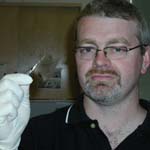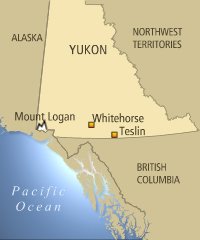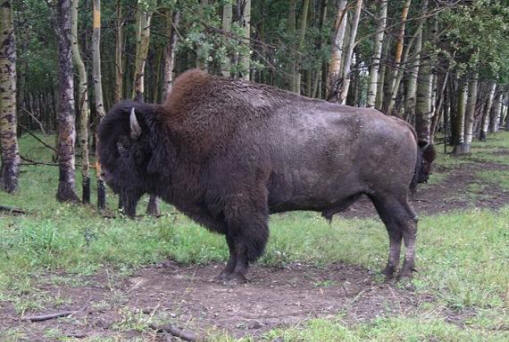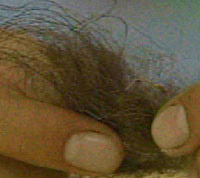
July 19, 2008

I look forward to seeing as many of you as I can at my 2:00 PM Mountain Time cryptozoology presentation tomorrow, Sunday, July 20th at the Royal Alberta Museum in Edmonton.
Since I’m in Alberta, I thought I would re-visit this story from 2005. Perhaps I will even be able to meet David Coltman (above) and obtain some of the Teslin “Sasquatch” hair for the cryptozoology museum.
Because Coltman’s subsequent analysis turned into a negative result, I feel the episode did not get enough widespread notice in hominology and cryptozoology circles. The event was actually something of a milestone, to have a scientist take to heart the full analysis of hair said to be from a “Sasquatch,” and then get his results published.

It is always good to see scientific papers being written on the search for authenticity versus fakery occurring in the collection of Bigfoot evidence.

In July 2005, the discovery of a strand of Sasquatch hair near Teslin, Yukon, followed a series of sightings that got a lot of press attention. The anticipation of the DNA tests on the hair became high drama in the media. David Coltman, a geneticist at the University of Alberta, finally determined that the sample was from the hair of a bison, not a higher primate, such as a Bigfoot.

Considering this was found to be bison hair from the Yukon, one might have thought it could be wood bison hair. Coltman’s analysis appears to have compared the hair to plains bison hair only. I’ll have to look into that angle.
Coltman said the hair not only came from a bison but was from a long-dead animal. He said the DNA was highly degraded and of very low quality, indicating that it had either been exposed for a long time to moisture and sunlight, or came from a hide that had been tanned.

Privately, in a 2005 interview, Coltman told me further that it appeared to be bison hair from a treated rug, and thus he felt almost certain what was happening was an attempt at hoaxing.
I have a less sinister suggestion for how this happened. The sample was found on a doorway looking out onto the yard where the Sasquatch was sighted. Perhaps this is an innocent mistake? Perhaps the sighting and the hair sample were linked, when they should have not? Maybe the hair got attached to the door frame due to the shaking out of an old buffalo rug? Maybe it was a coincidence finding that hair there, which got blown up into a “Sasquatch hair sample.”
Coltman did publish a scientific article on the analytic episode, “Molecular cryptozoology meets the Sasquatch,” by David Coltman and Corey Davis, Trends in Ecology and Evolution 21 (2006).
You may download it from the University of Alberta, via clicking here, as a pdf.

While Coltman does not discuss the rug theory in his formal paper, it is good to see the methodology for the bison finding detailed.

From a cryptozoologically point-of-view, if you are an investigator, always be aware of the environment in which you are, be on the lookout for common sources of hoaxing as you interview eyewitnesses, especially if they give you hair samples. Try to take notice if that’s a bison rug in the front room, under that chair in which you are sitting. 🙂
Some of the more interesting hoaxed “Bigfoot hair samples” have originated from horse owners, taxidermy specimens, taxidermists, and the eyewitnesses’ camel hair brushes. Do accept samples, while remembering, that the “evidence” is only as good as the credibility of the source.
About Loren Coleman
Loren Coleman is one of the world’s leading cryptozoologists, some say “the” leading living cryptozoologist. Certainly, he is acknowledged as the current living American researcher and writer who has most popularized cryptozoology in the late 20th and early 21st centuries.
Starting his fieldwork and investigations in 1960, after traveling and trekking extensively in pursuit of cryptozoological mysteries, Coleman began writing to share his experiences in 1969. An honorary member of Ivan T. Sanderson’s Society for the Investigation of the Unexplained in the 1970s, Coleman has been bestowed with similar honorary memberships of the North Idaho College Cryptozoology Club in 1983, and in subsequent years, that of the British Columbia Scientific Cryptozoology Club, CryptoSafari International, and other international organizations. He was also a Life Member and Benefactor of the International Society of Cryptozoology (now-defunct).
Loren Coleman’s daily blog, as a member of the Cryptomundo Team, served as an ongoing avenue of communication for the ever-growing body of cryptozoo news from 2005 through 2013. He returned as an infrequent contributor beginning Halloween week of 2015.
Coleman is the founder in 2003, and current director of the International Cryptozoology Museum in Portland, Maine.
Filed under Artifacts, Bigfoot, Breaking News, Cryptomundo Exclusive, Cryptotourism, CryptoZoo News, Cryptozoologists, Cryptozoology, Evidence, Forensic Science, Hoaxes, Sasquatch